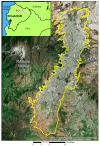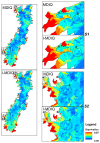Comparing Classic and Interval Analytical Hierarchy Process Methodologies for Measuring Area-Level Deprivation to Analyze Health Inequalities
- PMID: 29337915
- PMCID: PMC5800239
- DOI: 10.3390/ijerph15010140
Comparing Classic and Interval Analytical Hierarchy Process Methodologies for Measuring Area-Level Deprivation to Analyze Health Inequalities
Abstract
Deprivation indices are useful measures to study health inequalities. Different techniques are commonly applied to construct deprivation indices, including multi-criteria decision methods such as the analytical hierarchy process (AHP). The multi-criteria deprivation index for the city of Quito is an index in which indicators are weighted by applying the AHP. In this research, a variation of this index is introduced that is calculated using interval AHP methodology. Both indices are compared by applying logistic generalized linear models and multilevel models, considering self-reported health as the dependent variable and deprivation and self-reported quality of life as the independent variables. The obtained results show that the multi-criteria deprivation index for the city of Quito is a meaningful measure to assess neighborhood effects on self-reported health and that the alternative deprivation index using the interval AHP methodology more thoroughly represents the local knowledge of experts and stakeholders. These differences could support decision makers in improving health planning and in tackling health inequalities in more deprived areas.
Keywords: analytical hierarchy process; deprivation; inequality; self-reported health; self-reported quality of life.
Conflict of interest statement
The authors declare no conflict of interest.
Figures


References
MeSH terms
LinkOut - more resources
Full Text Sources
Other Literature Sources
Medical

